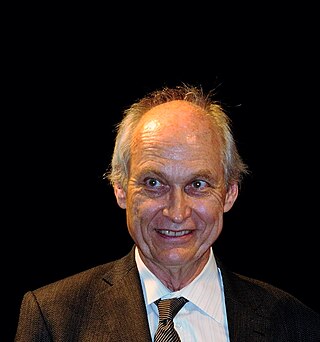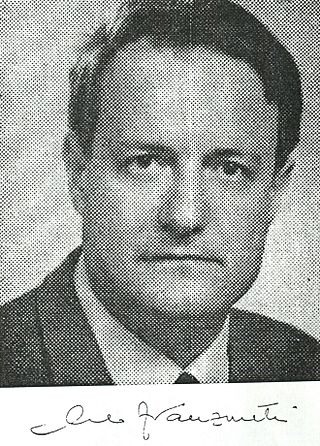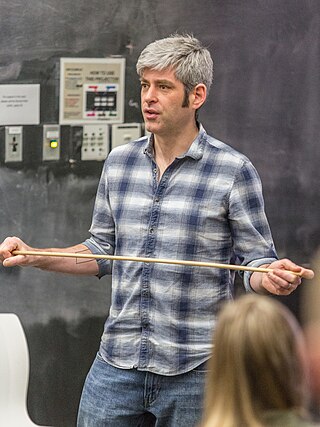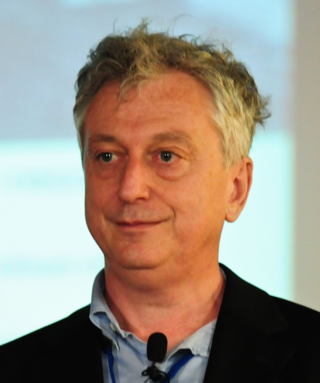Related Research Articles

Michael S. Turner is an American theoretical cosmologist who coined the term dark energy in 1998. He is the Rauner Distinguished Service Professor Emeritus of Physics at the University of Chicago, having previously served as the Bruce V. & Diana M. Rauner Distinguished Service Professor, and as the assistant director for Mathematical and Physical Sciences for the US National Science Foundation.

Helen Rhoda Arnold Quinn is an Australian-born particle physicist and educator who has made major contributions to both fields. Her contributions to theoretical physics include the Peccei–Quinn theory which implies a corresponding symmetry of nature(related to matter-antimatter symmetry and the possible source of the dark matter that pervades the universe) and contributions to the search for a unified theory for the three types of particle interactions. As Chair of the Board on Science Education of the National Academy of Sciences, Quinn led the effort that produced A Framework for K-12 Science Education: Practices, Crosscutting Concepts, and Core Ideas—the basis for the Next Generation Science Standards adopted by many states. Her honours include the Dirac Medal of the International Center for Theoretical Physics, the Oskar Klein Medal from the Royal Swedish Academy of Sciences, appointment as an Honorary Officer of the Order of Australia, the J. J. Sakurai Prize for Theoretical Particle Physics from the American Physical Society, the Karl Taylor Compton Medal for Leadership in Physics from the American Institute of Physics, the 2018 Benjamin Franklin Medal in Physics from the Franklin Institute, and the 2023 Harvey Prize from Technion -- Israel Institute of Technology.

Carlo Franzinetti was an Italian experimental physicist.
Mauro Francaviglia was an Italian mathematician.
General antiparticle spectrometer (GAPS) is a planned experiment that will use a high-altitude balloon flying in Antarctica to look for antideuteron particles from outer space cosmic rays, in an effort to search for dark matter. Anti-deuterons could perhaps be produced by the annihilation of hypothetical weakly interacting massive particles (WIMPs). The goal of the GAPS experiment is to capture anti-deuterons in a target material, to form an exotic atom in an excited state. The exotic atom would quickly decay, producing detectable X-rays energies with pion signature from nuclear annihilation.

Antonio Rostagni was an Italian physicist and academician.

Paolo Giubellino is an experimental particle physicist working on High-Energy Nuclear Collisions. Currently he is the joint Scientific Managing Director of the Facility for Antiproton and Ion Research (FAIR) and the GSI Helmholtz Centre for Heavy Ion Research (GSI) and Professor at the Institute of Nuclear Physics of the Technische Universität Darmstadt.
Marc Kamionkowski is an American theoretical physicist and currently the William R. Kenan, Jr. Professor of Physics and Astronomy at Johns Hopkins University. His research interests include particle physics, dark matter, inflation, the cosmic microwave background and gravitational waves.

Tracy Robyn Slatyer is a professor of particle physics with a concentration in theoretical astrophysics with tenure at MIT. She was a 2014 recipient of the Rossi Prize for gamma ray detection of Fermi bubbles, which are unexpected large structure in our galaxy. Her research also involves seeking explanations for dark matter and the gamma ray haze at the center of the Milky Way. In 2021, she was awarded a New Horizons in Physics Prize for "major contributions to particle astrophysics, from models of dark matter to the discovery of the "Fermi Bubbles."

JoAnne L. Hewett is a theoretical particle physicist on the faculty of the SLAC National Accelerator Laboratory at Stanford University, where she is a professor in the Department of Particle Physics and Astrophysics. Since 2017 she has been the associate lab director of the Fundamental Physics Directorate and the chief research officer at SLAC. Her research interests include physics beyond the Standard Model, dark matter, and hidden dimensions. She is a fellow of the American Physical Society and a fellow of the American Association for the Advancement of Science (AAAS).

Daniel Wayne Hooper is an American cosmologist and particle physicist specializing in the areas of dark matter, cosmic rays, and neutrino astrophysics. He is a senior scientist at Fermi National Accelerator Laboratory and a professor of astronomy and astrophysics at the University of Chicago.

Glennys Reynolds Farrar is a professor of physics at New York University who specializes in particle physics, cosmology and the study of dark matter. She has made several significant contributions to the fields of hadron and dark matter phenomenology, helping to develop the working "Standard Cosmological Model". Farrar is a figure in developing many modern particle-search techniques, achieving numerous recognitions including as the Guggenheim Fellowship for Natural Sciences and Sloan Fellowship. She holds a faculty position at New York University (NYU), where she has been since 1998.
Brenda Lynn Dingus is an American particle astrophysicist at the Los Alamos National Laboratory, known for her research on gamma-ray bursts and cosmic rays.

Luigi Arialdo Radicati di Bròzolo was an Italian theoretical physicist

Alessandro De Angelis is an Italian and Argentine physicist and astrophysicist. A Professor of Experimental Physics at the University of Padova and Professor Catedratico of Astroparticle Physics at IST Lisboa, he is mostly known for his role in the proposal, construction and data analysis of new telescopes for gamma-ray astrophysics. He is a member of Istituto nazionale di fisica nucleare (INFN), Istituto nazionale di astrofisica (INAF), Italian Physical Society (SIF), International Astronomical Union (IAU), Gruppo2003.
Cecilia Lunardini is an Italian nuclear astrophysicist known for her research on neutrinos from the sun, from the cosmic neutrino background, from supernovae and failed supernovae, and from collisions of stars with black holes. She is a professor of physics at Arizona State University.
Teresa Montaruli is an Italian astronomer specializing in neutrino astronomy, and in particular in the search for high-energy neutrinos from cosmic sources. She is a professor in the particle physics department at the University of Geneva.
Rosalba Perna is an Italian and American theoretical astrophysicist whose research concerns high-energy cosmic sources including gamma-ray bursts and neutron star mergers. She has also studied exoplanets and the growth of supermassive black holes. She is professor of physics and astronomy at Stony Brook University.
Ina Šarčević is a Yugoslav-American theoretical astrophysicist who studies high-energy cosmic particles, especially neutrinos, and the implications of particle physics for dark matter and cosmology. She is a professor of physics and of astronomy at the University of Arizona.
Adrienne Lynn Erickcek is an American theoretical cosmologist whose research aims at understanding cosmic inflation, dark matter, dark energy and chameleon particles, and alternatives to general relativity such as f(R) gravity. She is an associate professor in the Department of Physics and Astronomy at the University of North Carolina at Chapel Hill.
References
- 1 2 3 4 Fiorenza DONATO, Accademia delle Scienze di Torino, retrieved 2022-07-26
- ↑ Prof. Fiorenza Donato, University of Turin, retrieved 2022-07-26; see also linked curriculum vitae
- ↑ "Fellows nominated in 2015 by the Division of Astrophysics", APS Fellows archive, American Physical Society, retrieved 2022-07-26